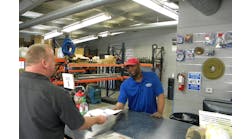If you're not growing, you're sliding backwards. This business mantra is not always true, but it usually is. If you aren't thinking of new ways to expand your market share, you will probably lose some of it because your competition is looking for ways to snatch it.
There are various ways to grow a rental business. Sometimes the logical course is to expand by opening new branches. National companies obviously use geographic expansion as a strategy, while local companies extend their reach into nearby towns.
Some companies grow their business by expanding into different product segments. Others choose to grow market share by enhancing their marketing, reaching more customers through new advertising methods.
Every company faces unique challenges when it comes to expansion methods. While researching this month's cover story on Stowers Rents, east Tennessee's inventive Caterpillar dealer, I thought about another challenge — growing a business within a defined territory. If Stowers was just a regular rental company, it could spread into west Tennessee, Georgia, Kentucky or Alabama. But Stowers is part of the Caterpillar dealer network and can't just set up branches in territories belonging to other dealerships. Many manufacturers have gone away from exclusive dealership territories, so for rental companies this is less of a problem than in the past. Or, if expanding into a certain area means encroaching on the territory of another company that handles the same product, they just won't handle that product in that region.
Caterpillar, on the other hand, has one of the construction industry's strongest — if not the strongest — dealer networks, and the fact that dealers respect the integrity of it adds to its effectiveness. For Stowers, geographic expansion opportunities are limited. So how to make the most of a territory with less than 2 million inhabitants? One would say this dealership coming up on $200 million in annual revenue has figured it out already. It offers very strong product support, it has a truck-engine repair business — with I-40 running right through east Tennessee, it makes the most of its opportunities — and one of the most effectively managed rental divisions I've seen, Caterpillar or otherwise.
Stowers Rents can still expand within its territory, checking out areas that might otherwise be overlooked if it had the freedom to expand wherever it wanted. And it can develop product niches, such as equipment especially for landscaping contractors.
Stowers is an example of smart business thinking. Every business faces limitations. The most successful ones figure out the best way to succeed in spite of them by finding the opportunities they might otherwise overlook.
With this issue RER begins a new column called Innovation on Rent. We recently asked readers to tell us about their innovations, and we heard some great stories. In this issue, we report on a company that responded to this country's drive-through culture by starting a drive-through rental procedure. If customers can buy food, bank and do a number of other tasks without leaving their car, why not rent equipment that way? Tiffin Rental is probably not the first to try, but please check out our report on this pioneering effort on page 18.
By now, most of you have heard about the acquisition of RSC Rentals from Atlas Copco by two private equity groups. If by chance you haven't, you can read about it on page 22. Some people thought it was a great deal for Atlas Copco; others thought they should have gotten an even better price.
I don't expect the new owners to ask my opinion on how to manage their $3.8 billion investment, but I'll offer my two cents anyway. I'm not suggesting that they don't already know it, but I hope they remember that numbers and metrics and systems and technology are all extremely important in the rental business, becoming more so all the time, and of course they are in business to make a profit and are concerned about ROI. But it still comes down to people and relationships.
I've been interviewing contractors for years, and while conditions change and the technology becomes more sophisticated, it still holds true that customers like to deal with people they've developed relationships with. And they repeat the same points, year after year: Return my phone calls on time, deliver to me when you promise, and back me up immediately when something breaks down. And if you don't, I'll find somebody who will.
If the new owners never lose sight of those goals, and let the people who know how to achieve them run the business, return on investment will be fine.





